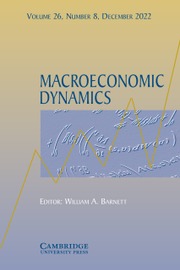Article contents
A NEW LOOK AT THE DIAMOND SEARCH MODEL: STOCHASTIC CYCLES AND EQUILIBRIUM SELECTION IN SEARCH EQUILIBRIUM
Published online by Cambridge University Press: 16 January 2001
Abstract
We recast Diamond's search equilibrium model into that with a finitenumber of agents. The state of the model is described by ajump-Markov process, the transition rates of which are functions ofthe reservation cost, which are endogenously determined by valuemaximization by rational agents. The existence of stochasticfluctuations causes the fraction of the employed to move from onebasin of attraction to the other with positive probabilities when thedynamics have multiple equilibria. Stochastic asymmetric cycles thatarise are quite different from the cycles of the set of Diamond–Fudenberg nonlineardeterministic differential equations. By taking the number of agents to infinity, we get alimiting probability distribution over the stationary stateequilibria. This provides a natural basis for equilibrium selectionin models with multiple equilibria, which is new in the economicliterature.
Keywords
Information
- Type
- Research Article
- Information
- Copyright
- © 2000 Cambridge University Press
- 14
- Cited by

